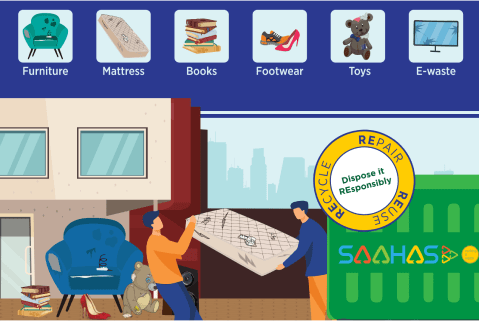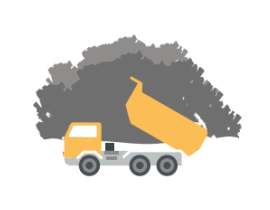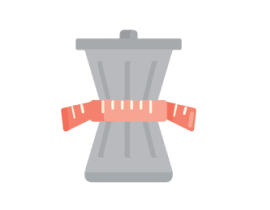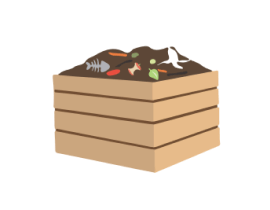Source Segregation
Source Segregation
By practicing source segregation, we can recover up to 90% of resources from our waste & become an enabler for the shift from a linear to a circular economy.
Different streams of waste

Special streams of waste

Construction and Demolition waste
Waste generated from construction, remodeling, repair and demolition of any civil structure. When segregated into these categories at the point of generation, 70% can be recycled and the rest can be managed without adding to air pollution and harm to water bodies.



Bulky waste
Bulky Waste consists of solid waste generated by residential premises which, by virtue of its mass, shape, size or quantity is inconvenient to be accommodated in the daily door to door collection system provided by the municipal corporation. Example - furniture, mattresses, books, toys, e-waste and footwear

E-waste
Electronic waste or e-waste describes discarded electrical or electronic devices such as TV appliances, computers, laptops, tablets, mobile phones, white goods - for example, fridges, washing machines, dryers - home entertainment and stereo systems, toys, toasters and kettles. Globally, India is the 3rd largest producer of E-Waste – 3.2 million metric tonnes in 2019. 82% are household items, while 12% are our phones alone. Extraction of metals for our electronics and electrical goods require mining. The entire process of extraction and processing of new metals directly contribute to Climate Change – mining leads to extensive deforestation while polluting the environment and releasing carbon dioxide in the atmosphere. Alternatively, if individuals and household consumers repair and reuse more often, we can reduce the amount of E-waste generated. If all of us discard our E-waste with only authorised recyclers, we can increase the percentage of E-waste recycling from 10% currently to much higher, and ensure metal recovery from our E-waste to be reused in our E-products. This process can remarkably reduce our carbon footprint and also save our environment from being polluted.

Why segregate?








FAQ
Waste segregation means keeping biodegradables and non - biodegradables separately so that non-biodegradable waste can be recycled and biodegradable waste can be composted.
So that it reduces waste that gets landfilled and reduces pollution to air and water. Segregation enables the different processes - composting, recycling and incineration to be applied to different kinds of waste .
- Keep separate containers for non-biodegradable and biodegradable waste in the kitchen.
- Keep glass /plastic containers rinsed of food matter.
- Send biodegradable waste out of the home daily.
- Store and send non-biodegradable waste out of the home, once/twice a week as applicable in your community.
- Store Household Hazardous waste, Sanitary waste and inerts in a separate bin.
- Store e-waste in a separately
Paper, plastics, metal, glass, rubber, thermocol, Styrofoam, fabric, leather, rexine, wood –anything that can be kept for an extended period without it decomposing.
Not if it is clean and dry. Make sure that plastic sachets of milk, curds, oil, dosa/idli batter, or any food item, are cleaned of all their contents and dried before being put in the non-biodegradable waste bag. Then they will never stink.
- Form a group of like-minded people
- Explain waste segregation to your family / neighbours in your apartment building.
- Get the staff in the apartment building to also understand the concept.
- Get separate storage drums for storing the non-biodegradable waste and biodegradable waste.
- Have the non-biodegradable waste picked up by the non-biodegradable waste collection centre or your local scrap dealer
This will happen only if any food residue or organic matter is present in the non-biodegradable waste. Clean and dry non-biodegradable waste will not attract any vermin.
Clean the pizza or cake boxes of all food residues – with a biodegradable kitchen cloth, or rinse them quickly in water and let them dry out before putting them in the non-biodegradable bin.
Sauce bottles should be rinsed thoroughly with water. Pickle bottles need to be cleaned with soap and water, as they contain oil. Basically, no food residue must be left in the bottles. Clean them as you would to reuse them.
Clean them thoroughly. Open out the milk, yoghurt, and dosa/idli batter packets completely at one end and wash out all the residue. They can be put to wash with the dishes in the sink, then dried, and put into the non-biodegradable waste bin.
Yes! Any plastic containing any food has to be rinsed, or washed with soap and water if required, before being put into the non-biodegradable waste bag
Yes, otherwise ants will be attracted to the sugar in the juice.
Make sure all the bread / biscuit crumbs are shaken out of the packet, so they do not attract ants. If the biscuits are too oily, the packet may need to be washed with soap and water.
If they are still in usable condition, they should be given to any organization that collects them. If they are totally unusable, or extremely damaged, they are categorized as non-biodegradable waste. If clothes are soiled with body fluids, they become sanitary waste. If they are soiled with paint or any chemicals, they are HHW (household hazardous waste). Both sanitary waste and HHW should be stored in the Hazardous waste bin.
Same as above
Old furniture can be recycled. If not, it can disposed of as debris or rubbish (inerts) along with broken glass.
If they are not broken, they are recyclable non-biodegradable waste. If broken, debris or rubbish (inerts).
Old taps – recyclable non-biodegradable waste. Broken sanitary ware – debris or rubbish (inerts).
Bathroom cleaning brush is sanitary waste.
Store it in a bag or bin in the utility area after cleaning and drying till it is picked up.
E-waste or electronic waste consists of batteries, computer parts, wires, electrical equipment of any kind, electrical and electronic toys, remotes, watches, cell phones as well as bulbs, tube lights and CFLs.
Store these in separate container which is kept closed, away from moisture and in which nothing else is kept. It has to be collected periodically as a separate waste stream.
Tube lights, bulbs and CFLs fall under the category of e-waste.
Biodegradable waste consists of kitchen waste – including vegetable and fruit peels and pieces, tea leaves, coffee grounds, eggshells, bones and entrails, fish scales, as well as cooked food (both veg and non-veg ).
Of course! Home composting can be easily done in any aerated container. Specialized kits are also commercially available.
If you live in a large apartment building, a community composting system like tank composting or pit composting could be set up for all the biodegradable waste from the residents. If not, the biodegradable waste can be given out every day to the collection staff.
Before the advent of the bin liner, we would all put our garbage directly in the bin, and wash it every day. That is what we will have to do now. The bin can be lined with a newspaper liner or a layer of sawdust if you don’t want to put the biodegradable waste directly into it.
HHW or Household Hazardous Wastes include toxic substances such as paints, cleaning agents, solvents, insecticides and their containers, other chemicals; and biomedical wastes like used syringes, expired medicines, thermometers, used cosmetics etc.
This includes used menstrual cloths, sanitary napkins, disposable diapers, bandages, and any material that is contaminated with blood or other body fluids.
They should be wrapped in a newspaper, marked with a red cross and given along with the Hazardous waste.
Expired medicines and injections, used syringes, and razors come under HHW or household hazardous wastes. Condoms, soiled cotton, etc. come under sanitary waste – they should be wrapped in a newspaper, marked with a red cross, and given along with the Hazardous waste.
Used waxing strips are sanitary waste – they should be disposed along with Hazardous waste. Cosmetics come under hazardous wastes.
They come under HHW or household hazardous wastes. They should be stored separate from Biodegradable and non-biodegradable waste.
It is considered sanitary waste, to be disposed along with Hazardous waste. In case the dog or cat has loose motions, do the same with the cloth used to mop up the liquid poop.
It is considered sanitary waste.
Small amounts can be mixed with the biodegradable waste. If it is substantial quantity, it has to be handed over separately to the collection staff for use in composting unit.